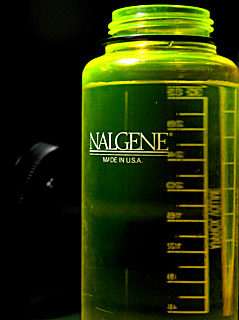
Photo Illustration by SAUL LOEB
|
|
By Natasha Bhuyan
Arizona Daily Wildcat
Friday, September 10, 2004
Print this
New study contradicts previous findings that Nalgene bottles unsafe
Studies done last year found popular Nalgene water bottles to be potentially toxic, but new research, done in part by a UA professor, suggests the bottles do not pose a risk.
A study done by the University of Missouri reported that a chemical called bisphenol-A seeps into water that is stored in polycarbonate plastic, the same kind used in Nalgene Lexan's outdoor water bottles.
According to the study, published in the July 2003 issue of Environmental Health Perspectives, detectable levels of BPA leaked into drinking water stored at room temperature.
Additional studies were conducted nationwide to find adverse effects of BPA, which is known to mimic the female hormone estrogen.
According to a Case Western Reserve University study, rats exposed to BPA developed aneuploidy, an abnormal loss or gain of chromosomes. The defect in humans can result in Down syndrome or cancer.
But Glenn Sipes, UA professor and department head of pharmacology, said the studies are misleading.
Sipes was a member of a research panel created by the Harvard Center for Risk Analysis that studied how humans handle chemical compounds in comparison to the laboratory rats that are used for scientific research.
The purpose of the panel, which lasted two years, was to analyze recent scientific studies and find if humans handle compounds in a similar manner to rats, since rats are a common test species, Sipes said.
But Sipes said his research panel found the Nalgene studies should be interpreted with caution.
"Yes, you can report in literature that this happened or that happened," said Sipes. "But these biological health effects did not translate into big issues of concern."
Sipes said his panel found that humans metabolize the BPA more effectively than the rats that were used as test species. Humans also clear the chemical out of their bodies a few hours after ingestion, Sipes said.
The panel also studied the health effects BPA can have at varying doses. What makes BPA unique, Sipes said, is that some scientists believe it has harmful side effects even at low doses.
"But if you look at reproductive or birth defects ... you don't get adverse long-term degenerative health effects," said Sipes.
Marti Lindsey, the assistant director at the UA's Center for Toxicology, said students should consider different factors when reading about the Nalgene water bottle studies. The length of time water is left in a container, the amount of BPA ingested, and the use of animals instead of humans can influence whether BPA is a genuine threat, Lindsey said.
"The studies don't translate into real health hazards," Lindsey said.
Despite the publications surrounding the Nalgene bottles last year, the popularity of the water bottles has not seemed to dwindle on campus.
Danielle Bennett, a graduate student in public administration, said she likes how durable the bottles are.
"I like how it doesn't break," Bennett said. "I feel like there could be chemicals in any plastic bottle I use."
Claire Stillwell, a microbiology junior, said she is not worried about using her Nalgene bottle because there are already chemicals everywhere.
"I'm not afraid to die," Beth James, a veterinary science senior, joked.
Dominic McGrath, associate professor of chemistry, said people are exposed to chemicals every day. For example, a "new car smell" is an organic compound released from the materials used to make the interior of the car, McGrath said.
"You cannot worry about everything some news report calls a 'chemical,'" McGrath said. "You just have to use common sense."
However, if students are concerned about their Nalgene water bottles, McGrath advised frequently rinsing bottles, using fresh water, and not putting a hot liquid into a Nalgene bottle.
The Nalgene Outdoor Products Web site also addressed the BPA issue, defending the safety of Nalgene water bottles based on the findings from the Food and Drug Administration, Environmental Protection Agenc, and American Plastics Council.
